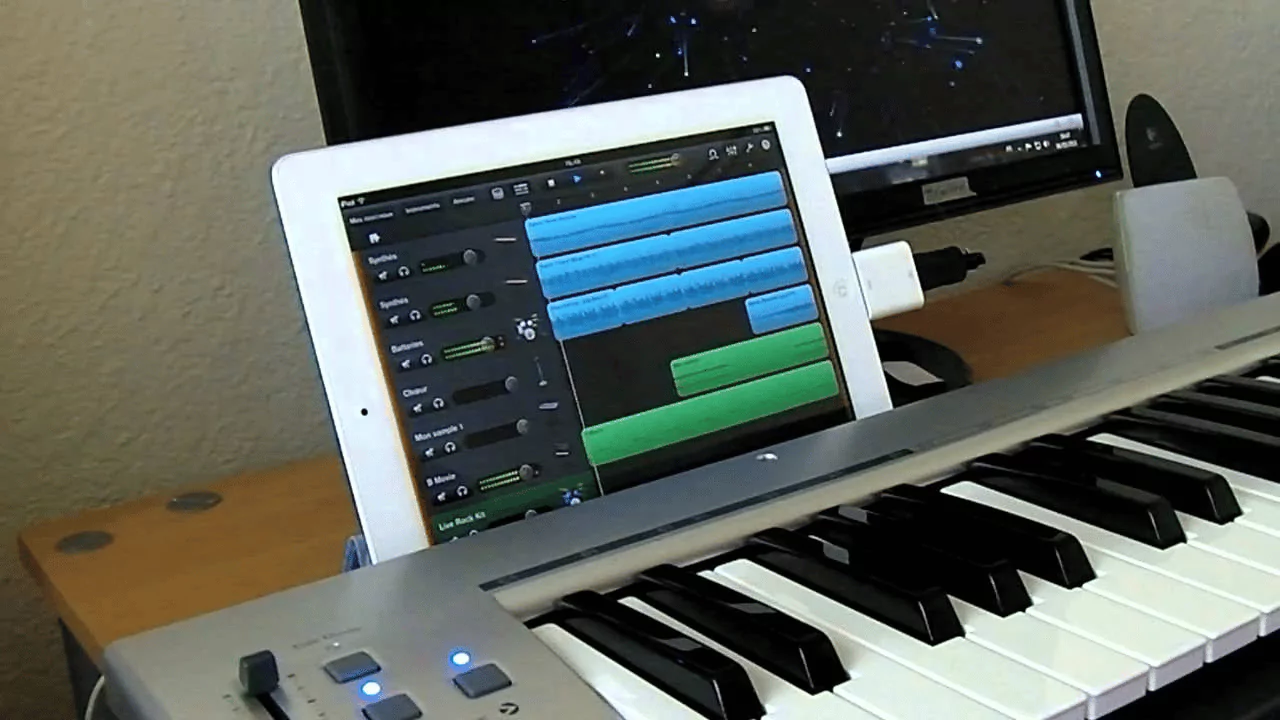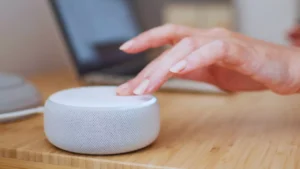Are you looking to enhance your music production skills with Garageband? One tool that can take your compositions to the next level is a MIDI keyboard. In this article, we will explore the world of MIDI keyboards and discover how they can elevate your music-making experience with Garageband.
In This Article:
What Is A MIDI Keyboard?
A MIDI keyboard is a versatile electronic instrument that uses the Musical Instrument Digital Interface (MIDI) protocol to send and receive musical performance data.
It allows musicians to control and manipulate various aspects of sound production, such as pitch, duration, intensity, and timbre, all through the use of keys, knobs, sliders, and other controls. MIDI keyboards are widely compatible with digital audio workstations (DAWs), providing seamless integration for music production.
Whether it’s composing, arranging, recording, or performing live, a MIDI keyboard serves as a central tool, enabling users to express their musical ideas efficiently and creatively. With features like velocity sensitivity, aftertouch, and assignable controls, these keyboards offer a dynamic and expressive platform for musicians and producers.
What Are The Benefits Of Using A MIDI Keyboard With Garageband?
Using a MIDI keyboard with Garageband offers numerous advantages, including enhanced control over software instruments, intuitive piano roll editing, and seamless integration with the Garageband environment.
Better Control And Expression
One of the key benefits of using a MIDI keyboard with Garageband is the ability to achieve better control and expression through velocity-sensitive keys, assignable controllers, and intuitive smart controls.
Velocity sensitivity allows the player to convey a wide range of dynamics, from delicate pianissimo to powerful fortissimo, adding a natural, human-like feel to the music. The assignable controllers enable customization, granting the user the freedom to map functions like pitch bend, modulation, and effects to suit their playing style and preferences.
Smart control integration provides seamless interaction with Garageband’s features, offering quick access to parameters and settings.
More Realistic Instrument Sounds
Using a MIDI keyboard with Garageband enables access to more realistic instrument sounds, precise pitch modulation, and seamless note input for creating authentic musical compositions.
The advanced sound realism and note manipulation capabilities offered by MIDI keyboards have revolutionized the way software instruments are performed. With these keyboards, musicians can achieve a more expressive and nuanced performance, mimicking the dynamics and articulations of acoustic instruments.
The pitch modulation control provided by MIDI keyboards allows artists to infuse their music with subtle variations and emotive depth, enhancing the overall sonic quality of their compositions.
The precise note input precision of MIDI keyboards ensures that every musical idea is accurately translated into digital form, giving the power to composers to realize their creative vision with unparalleled accuracy and efficiency.
Easy Editing And Recording
Utilizing a MIDI keyboard with Garageband simplifies the process of editing and recording music, providing intuitive access to the piano roll, track settings, and efficient input/output configurations.
With the piano roll navigation feature, MIDI keyboards allow users to visualize and manipulate musical notes, offering a streamlined approach to editing melodies and harmonies. The seamless integration with track settings enables quick adjustments to parameters such as volume, panning, and effects, enhancing the overall sound production.
Additionally, MIDI keyboards facilitate efficient input/output management by enabling easy connection to external devices, such as synthesizers and sound modules, ensuring a smooth workflow in music creation.
How To Connect A MIDI Keyboard To Garageband?
To connect a MIDI keyboard with GarageBand, follow these steps:
- Connect the USB 2.0 or USB-C cable from the back of your MIDI keyboard to your computer’s USB port.
- If your computer has a USB-C port and your keyboard uses USB 2.0, use a USB-C to USB adapter.
- Open GarageBand on your computer.
- GarageBand will automatically recognize your MIDI device if it’s a plug-and-play keyboard like the AKAI MPK Mini. No additional steps are needed.
- If you have an older computer, you might not need a USB-C adapter, as the keyboard can connect directly through the USB port.
- In case you’re using an older MIDI keyboard with MIDI cables, use a MIDI to USB adapter or a MIDI interface like M-Audio’s 2×2 MIDISport.
Remember that GarageBand supports a variety of MIDI keyboards, and the process is generally the same for all of them. If you encounter any issues, check your input and output options in GarageBand’s settings, reset your MIDI drivers, and ensure your track is not muted or isolated. Additionally, restarting your PC and GarageBand while reconnecting the MIDI keyboard can help resolve any recognition problems.
For optimal performance, consider choosing a suitable MIDI keyboard for GarageBand based on your preferences and needs. Some recommended options include the AKAI MPK Mini Play, M-Audio Oxygen Pro 61, and M-Audio 88 Hammer Pro. These keyboards offer different key configurations to suit various requirements in music production.
How To Use A MIDI Keyboard In Garageband?
Using a MIDI keyboard in Garageband involves selecting it as the input device, choosing an instrument, recording and playing back MIDI notes, as well as utilizing advanced functions like muting, soloing, and restarting.
When setting up a MIDI keyboard in Garageband, it’s essential to ensure that it’s properly connected to your computer and recognized as the input device. Next, you can explore a wide range of instrument choices within the software, from classic pianos and synthesizers to intricate drum kits and exotic world instruments.
Recording MIDI notes is seamless in Garageband, allowing you to capture your musical ideas in real time or step-by-step. Playing back MIDI notes offers easy editing and manipulation, enabling you to refine your compositions effortlessly.
Furthermore, Garageband provides advanced functionalities such as muting specific tracks, soloing instruments for detailed adjustments, and restarting sections to perfect your musical arrangements. These features add depth and precision to your music production process, enhancing your creative possibilities.
Selecting The MIDI Keyboard As Input Device
To use a MIDI keyboard in Garageband, it is essential to select it as the input device in the software instrument settings, enabling seamless integration and responsive performance within the digital environment.
When setting up a MIDI keyboard, navigate to the preferences menu in Garageband and select ‘Audio/MIDI’ to ensure the keyboard is recognized as an available input device. Once the device is connected, Garageband should automatically detect it. After this, assign the MIDI channels and configure the keyboard’s response to velocity and other performance parameters. This will optimize the instrument’s functionality and enhance the musical experience.
Choosing An Instrument In Garageband
Garageband offers a diverse selection of software instruments that can be accessed using a MIDI keyboard, allowing users to choose and manipulate different sounds via the piano roll and note input functionalities.
Software instruments in Garageband provide a wide range of options for music production. When using a MIDI keyboard, users have the flexibility to experiment with various sounds, from classic pianos and synths to unique electronic and percussive elements.
The piano roll is a key feature for MIDI-enabled manipulation, enabling precise control over note placement, duration, and velocity. It allows composers to create intricate melodies and complex harmonies, while also providing the means to tweak and customize each individual note.
The software’s intuitive interface makes it easy to navigate through different sound selections, offering a seamless experience for users to find the perfect instrument or effect that matches their creative vision.
Recording And Playing Back MIDI Notes
Recording and playing back MIDI notes in Garageband using a MIDI keyboard involves interacting with the digital audio workstation (DAW), manipulating notes via the piano roll, and achieving precise musical input and playback.
When using a MIDI keyboard, the digital audio workstation (DAW) allows for seamless communication between the hardware and software, enabling musicians to record and playback MIDI notes with ease. The piano roll feature in Garageband offers a visual representation of the notes, allowing for precise manipulation and editing. This means that musicians can modify the timing, duration, and velocity of each note, creating a dynamic and expressive performance. The MIDI keyboard provides a tactile and responsive interface for recording musical ideas, resulting in a more natural and fluid input process.
Using The Modulation And Pitch Bend Wheels
MIDI keyboards with modulation and pitch bend wheels offer dynamic control over musical expression, allowing users to create nuanced performances and melodic variations within the Garageband environment.
The modulation wheel allows for real-time adjustment of parameters such as vibrato, tremolo, and timbre, giving musicians the ability to infuse their performances with emotional depth and expressiveness.
Conversely, the pitch bend wheel enables subtle or dramatic pitching variations, adding a human touch to synthesized sounds and enhancing the overall musicality of the performance. Together, these controls give the power to musicians to sculpt their sound with precision and finesse, elevating the expressiveness of their compositions.
What Are Some Tips For Using A MIDI Keyboard In Garageband?
To optimize the use of a MIDI keyboard in Garageband, it is beneficial to experiment with different instrument sounds, utilize keyboard controls for enhanced performance, leverage the MIDI editor for fine-tuning, and save customized settings for future use.
Experimentation with instrument sounds can lead to unique and personalized tracks that stand out in a composition. Additionally, MIDI keyboards offer the flexibility to experiment with various instrument libraries and sound patches, allowing users to discover new sounds and textures for their music.
Using keyboard controls, such as modulation wheels, pitch bend, and aftertouch, can add expressive nuances to performances, enriching musical expression and dynamics. These controls also enable musicians to convey emotion and depth in their playing, enhancing the overall impact of the music.
The MIDI editor is a powerful tool for refining and customizing note velocities, durations, and other parameters, enabling precise adjustments to the musical arrangement. This feature gives the power to users to craft intricate melodies, harmonies, and rhythmic patterns with meticulous attention to detail.
Once the desired instrument settings, performance nuances, and editing adjustments are achieved, saving custom presets or configurations can streamline future projects, providing quick access to preferred sounds and setups. This time-saving practice allows users to focus on creativity and production rather than repetitive setup tasks.
Experiment With Different Instrument Sounds
Exploring a diverse range of instrument sounds with a MIDI keyboard in Garageband allows users to customize settings, manipulate controllers, and craft unique sonic experiences for their musical projects.
With MIDI keyboards, users can experiment with different instrument sounds, from pianos and strings to synthesizers and drums, enhancing the versatility of their compositions. By diving into keyboard settings, one can alter parameters such as velocity sensitivity and aftertouch to achieve nuanced and expressive performances.
The controller manipulation capabilities of MIDI keyboards enable musicians to modulate sound characteristics, apply effects, and trigger loops in real-time, expanding the scope of sonic creativity. This hands-on approach give the power tos artists to infuse their tracks with personalized nuances, elevating the overall mood and depth of their music.
Use The Keyboard’s Controls To Enhance Your Performance
Leveraging the controls on a MIDI keyboard within Garageband can significantly enhance musical performance, offering dynamic adjustments, expressive capabilities, and seamless integration with smart controls for versatile sound manipulation.
The tactile nature of a MIDI keyboard gives the power to musicians to surpass the limitations of traditional keyboard interfaces. By mapping various parameters such as velocity, aftertouch, and modulation to different controls, performers can achieve finer nuances and articulations, breathing life into their compositions. The MIDI technology facilitates precise and swift response to touch, enabling a seamless transition between various intensities of sound and enhancing the dynamic range.
In the Garageband environment, this translates into an extensive palette of sonic possibilities. Musicians can effortlessly mold the tonal characteristics, shaping each note with unparalleled expressiveness. The smart control integration further amplifies this potential, granting access to customizable mappings and real-time adjustments, ensuring that the MIDI keyboard becomes an extension of the artist’s creativity.
Utilize The MIDI Editor For Fine-Tuning
The MIDI editor in Garageband offers powerful tools for fine-tuning musical compositions created with MIDI keyboards, enabling precise adjustments, note corrections, and creative enhancements via the intuitive piano roll interface.
This feature allows musicians to delve into every aspect of their compositions, adjusting the timing and duration of each note, correcting any inaccuracies, and adding expressive nuances to their melodies. The piano roll interface provides a visual representation of the musical notes, allowing for seamless editing and manipulation, making it a highly effective tool for refining musical expression.
Save Your Settings For Future Use
Saving customized settings and preferences for MIDI keyboards in Garageband ensures quick access to preferred configurations and streamlines the workflow for future music production sessions.
When musicians and producers can easily access their preferred MIDI keyboard settings, it eliminates the need to manually adjust parameters for each project, significantly saving time and effort. This optimization allows for a more seamless transition between different projects, making the creative process more efficient and productive.
The ability to save customized preferences on a MIDI keyboard allows for personalized configurations that cater to individual workflow needs. This personal touch not only enhances creative freedom but also ensures a consistent and comfortable working environment for the user.
Frequently Asked Questions
What is a MIDI keyboard and why should I use it with Garageband?
A MIDI keyboard is a musical instrument that uses digital signals to communicate with other devices, such as your computer. It offers a more intuitive and versatile way to create music in Garageband, allowing you to easily record, edit, and manipulate your sound.
How do I connect my MIDI keyboard to Garageband?
First, make sure your keyboard is connected to your computer via USB or MIDI cables. Then, open Garageband and go to Preferences > Audio/MIDI. Under the MIDI tab, select your keyboard in the list of devices. Garageband should now recognize your keyboard and you can start playing!
Can I use my MIDI keyboard to control different instruments and effects in Garageband?
Yes, you can assign different instruments and effects to different keys or buttons on your MIDI keyboard. This gives you the ability to switch between sounds and effects seamlessly while playing, adding depth and variety to your music.
How do I record my MIDI keyboard in Garageband?
To record your MIDI keyboard, simply arm the track you want to record on and press the record button. As you play on your keyboard, Garageband will record the MIDI data and translate it into the chosen instrument or sound. You can also adjust the recording settings under Preferences > Audio/MIDI > Recording to customize your recording session.
Can I edit my MIDI recordings in Garageband?
Yes, Garageband offers a range of editing tools for your MIDI recordings. You can quantize your recordings to fix any timing issues, adjust the volume and velocity of individual notes, and even change the instrument or sound of your recording after the fact.
Is it possible to use my MIDI keyboard with other music software besides Garageband?
Yes, most MIDI keyboards are compatible with a variety of music software, such as Logic Pro, Pro Tools, and Ableton Live. As long as your keyboard is connected to your computer and recognized as a MIDI device, you should be able to use it with any software that supports MIDI input.





